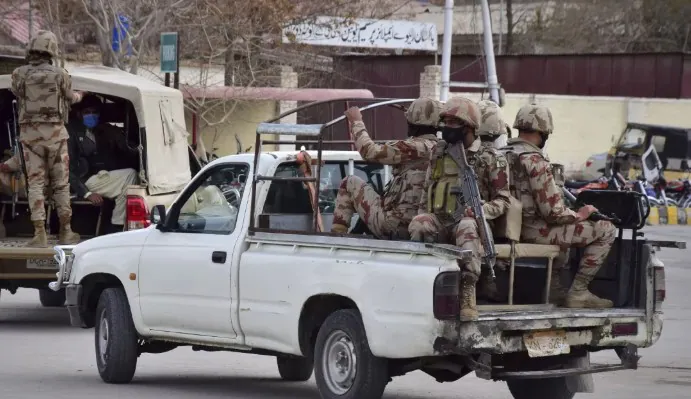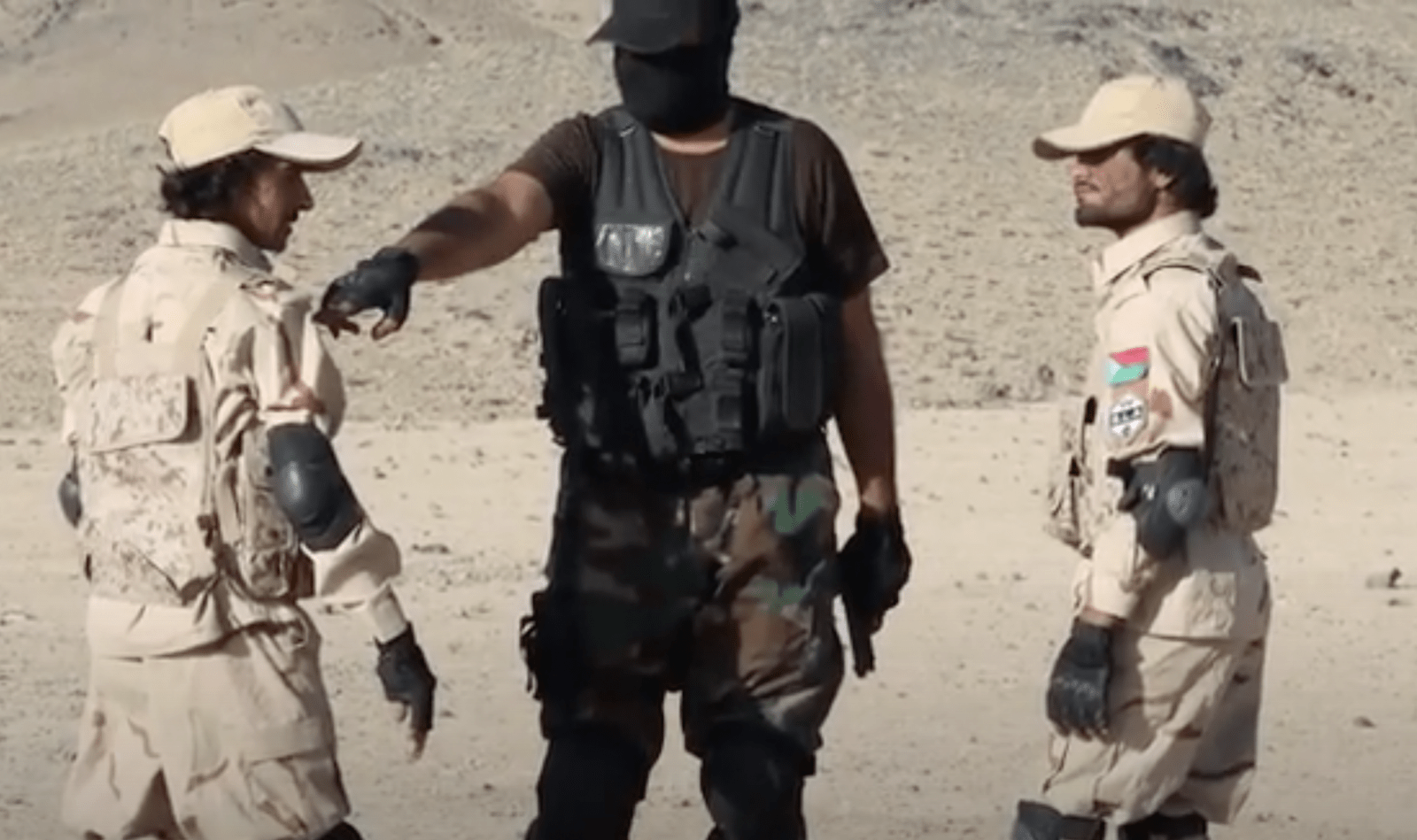
In yet another chilling reminder of the volatile situation in Balochistan, a powerful explosion on Monday claimed the lives of four Pakistani soldiers and left several others injured when a Pakistan Army vehicle was targeted in the restive region. The incident, which occurred on May 6, 2025, has intensified concerns over security lapses and the continuing unrest in a province long fraught with political instability and insurgent violence. The latest attack, attributed to the banned Balochistan Liberation Army (BLA), underscores the relentless threat of militancy in the region and the vulnerability of state forces operating in such high-risk territories.
This latest act of violence happened in the Gwadar district of Balochistan — a region strategically significant due to its proximity to the Arabian Sea and its pivotal role in the China-Pakistan Economic Corridor (CPEC). The convoy was ambushed in a calculated blast that not only took the lives of four personnel but also severely injured others, some of whom remain in critical condition. The Pakistan military, in a strongly-worded statement, condemned the attack and vowed to respond with “full force,” but the incident reignites pressing questions regarding the efficacy of counter-insurgency operations in Balochistan.
An Escalating Pattern of Insurgency
The Gwadar blast is not an isolated occurrence but part of an intensifying campaign of violence orchestrated by separatist groups operating within Balochistan. Over the last decade, the region has been plagued by frequent attacks, mainly targeting military convoys, infrastructure projects, and even civilians suspected of cooperating with state authorities. The Balochistan Liberation Army, which has claimed responsibility for the most recent attack, has been classified as a terrorist organization by both Pakistan and international entities. The group demands independence from Pakistan, citing decades of political neglect, economic exploitation, and human rights violations.
Over the years, Balochistan has turned into a battlefield between insurgent factions and the Pakistani state, with the ordinary citizens often caught in the crossfire. While the military continues to conduct large-scale operations to neutralize militant networks, the cycle of violence has remained largely unbroken. Monday’s attack only adds to this grim chronicle and places the spotlight once again on the fragile nature of peace in this troubled province.
Strategic Implications for CPEC and Regional Stability
Gwadar holds enormous strategic value not only for Pakistan but also for China, which has invested billions of dollars into the development of the port city as part of the Belt and Road Initiative (BRI). The China-Pakistan Economic Corridor is considered a cornerstone project of the BRI and serves as a vital link connecting Western China to the Arabian Sea. Given this backdrop, any disruption in Gwadar is not merely a national security concern for Pakistan but also has serious geopolitical ramifications.
The May 6 blast threatens to further complicate this already delicate equation. As security in Gwadar deteriorates, the confidence of foreign investors — particularly Chinese stakeholders — may begin to waver. Attacks like these not only cause immediate casualties but also have a chilling effect on development, foreign cooperation, and diplomatic relations. The repeated targeting of military vehicles and project sites has already prompted Beijing to ask for enhanced security assurances from Islamabad.
Civilian Lives in Peril as Conflict Deepens
Beyond the military and strategic dimensions, the impact of tused as pawns in a larger geopolitical struggle that shows no signs of abating.his ongoing conflict on civilian populations in Balochistan cannot be overstated. In recent years, human rights organizations have raised alarms about enforced disappearances, extrajudicial killings, and mass displacement as collateral damage in Pakistan’s war against insurgency. Monday’s blast serves as a stark reminder of how these communities continue to live under the looming threat of violence.
According to local sources, the explosion occurred near a civilian-populated area, amplifying the risk of collateral damage. Although this attack targeted a military vehicle, such incidents often lead to retaliatory measures that exacerbate civilian suffering. Local residents interviewed by regional media expressed both fear and helplessness in the wake of the incident. There’s a growing sentiment among Baloch communities that they have been forgotten, used as pawns in a larger geopolitical struggle that shows no signs of abating.
Reactions from Political and Military Leadership
Following the attack, Pakistani military officials were quick to respond with promises of retribution. In a press release, the Inter-Services Public Relations (ISPR) condemned the “cowardly act of terrorism” and reiterated their commitment to uprooting terrorism from the province. Prime Minister Shehbaz Sharif also issued a statement expressing condolences to the families of the martyred soldiers and reaffirmed the government’s resolve to bring the perpetrators to justice.
However, critics argue that such statements, while necessary, do little to address the structural issues at play. The government’s counterinsurgency strategies have often been reactive rather than proactive, failing to offer long-term solutions. The lack of meaningful political dialogue with Baloch nationalist groups has further alienated the local population, making them more susceptible to militant narratives. Calls are now growing louder for a multi-pronged approach that combines security measures with genuine political engagement.
A Growing International Concern
The Balochistan conflict, though often regarded as a domestic issue, has increasingly drawn international attention. Human rights watchdogs, regional allies, and even rival states have closely monitored the situation, particularly in light of the province’s strategic significance. The recent blast could become a tipping point, compelling international organizations to re-examine their partnerships and investments in Pakistan.
From a diplomatic standpoint, Monday’s blast may strain Islamabad’s relations with Beijing. China has repeatedly emphasized the need for robust security protocols to protect its workers and projects in Pakistan. Failure to ensure safety in key areas like Gwadar might compel China to reconsider its level of involvement in the region. At the same time, Western nations observing Pakistan’s internal dynamics may raise concerns about the growing instability and its implications for regional peace.

Historical Roots of the Conflict
The roots of the Balochistan insurgency go back decades, tracing a long history of political, economic, and cultural marginalization. Since Balochistan’s incorporation into Pakistan in 1948, there have been multiple uprisings — each met with varying degrees of military response. While some of these rebellions were subdued, they never truly ended. A sense of disenfranchisement continues to fuel local grievances.
Baloch leaders often argue that the province’s vast natural resources — including gas, minerals, and coastline access — have been exploited for national gain without adequate reinvestment into local communities. Moreover, Baloch language, culture, and identity have often been sidelined in the broader national discourse, creating a fertile ground for resistance. As long as these historical injustices remain unaddressed, peace will continue to be elusive in Balochistan.
The Need for Comprehensive Solutions
The tragic events of May 6 have reopened a vital national conversation about how best to restore peace and stability in Balochistan. Security operations, while essential, must be coupled with developmental initiatives and inclusive governance. Experts suggest that any lasting solution must involve stakeholders from across the political and social spectrum — including tribal elders, community leaders, civil society, and even moderate factions of the insurgent groups.
In this context, development alone cannot be seen as a cure-all. Infrastructure projects and foreign investments must be paired with community-based programs that build trust, generate employment, and respect local identities. Only then can the Pakistani state hope to wean away potential recruits from the influence of separatist ideologies and lay the foundation for durable peace.
A Nation on Edge, A Province in Peril
As the nation mourns the loss of its brave soldiers, it must also reflect on the long-term consequences of continued unrest in Balochistan. The attack is not merely a blow to the military establishment but a profound symbol of a deeper malaise afflicting the region. The persistence of violence, coupled with the lack of political engagement, creates a toxic cycle that threatens to destabilize not just Balochistan but the entire country.
If lessons are not learned from this latest tragedy, there is every likelihood that similar attacks will continue to haunt the region. The road to peace is undoubtedly long and fraught with challenges, but a comprehensive, inclusive approach may finally provide the light at the end of this dark tunnel.
Conclusion: Time to Rethink Balochistan Strategy
Monday’s devastating attack on a Pakistan Army convoy is a brutal chapter in Balochistan’s long history of unrest. As images of charred vehicles and grieving families flash across news screens, one truth becomes unavoidably clear: military might alone cannot solve the Balochistan crisis. What is needed is a fresh perspective — one that recognizes the legitimacy of local grievances while ensuring national integrity.
The government must take immediate steps to de-escalate tensions, initiate genuine dialogue, and provide security not just through the barrel of a gun but through policy, compassion, and cooperation. Until then, peace in Balochistan will remain a distant dream, and tragedies like the one on May 6 will continue to darken the nation’s conscience.

